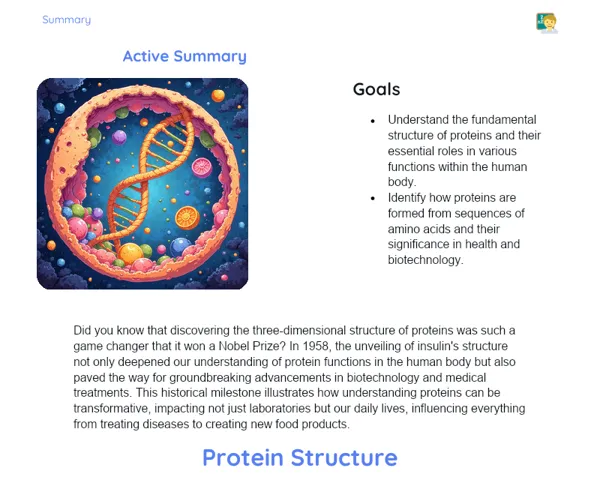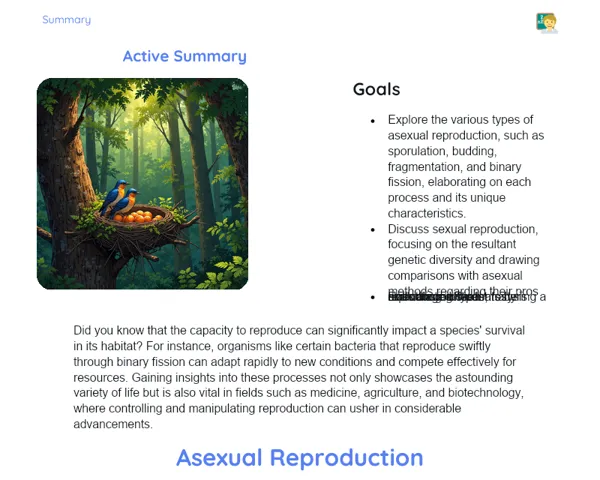Socioemotional Summary Conclusion
Goals
1. Grasp the structure and function of proteins that work within our body.
2. Learn how amino acids come together to form proteins.
Contextualization
Proteins are at the heart of nearly every biological process in our body. Think of a young sportsman following a protein-rich diet to build muscle and boost performance. When we understand the biochemistry behind proteins, we can make better choices for our meals and lead a well-balanced lifestyle. Let’s set off on this exciting journey into the world of proteins! 🏋️🍳
Exercising Your Knowledge
Primary Structure of Proteins
The primary structure is essentially the straight-line sequence of amino acids that makes up a polypeptide chain. This sequence, dictated by our genetic code, is fundamental to a protein’s unique function. Each amino acid links to the next via peptide bonds, forming a long chain that later twists and folds into more intricate shapes.
-
Amino Acid Sequence: Just as letters form a word, the order of amino acids establishes a protein’s identity and role.
-
Peptide Bonds: These are the covalent links joining the amino group of one amino acid with the carboxyl group of the next, essential for building the chain.
-
Genetic Code: Our DNA directs the amino acid sequence, directly influencing the structure and function of the protein.
Secondary Structure of Proteins
This stage involves the local folding of the polypeptide chain into set patterns like alpha-helices and beta-sheets. Such configurations are stabilized by hydrogen bonds along the backbone of the chain, providing the protein with its initial strength.
-
Alpha Helix: A spiral form reinforced by hydrogen bonds between every fourth amino acid, lending flexibility, much like the keratin in our hair.
-
Beta Sheet: A flattened structure where chains align side by side, seen in materials like silk.
-
Hydrogen Bonds: Though individually weak, these bonds collectively play a key role in stabilising the folded structure.
Tertiary Structure of Proteins
The tertiary structure is all about the three-dimensional folding of the polypeptide chain, creating a unique shape essential for the protein’s function. This conformation is reinforced by various interactions including disulfide bridges, hydrophobic interactions, ionic bonds, and hydrogen bonds.
-
Three-Dimensional Conformation: The final, fully folded shape that determines how the protein works, much like an enzyme’s shape aids in binding its specific substrate.
-
Hydrophobic Interactions: Amino acids that tend to avoid water cluster at the protein's core, helping maintain its structure.
-
Disulfide Bridges: Strong covalent bonds between the thiol groups of cysteine residues, providing extra structural stability.
Key Terms
-
Proteins: Large molecules made up of amino acids that perform vital functions in our body.
-
Amino Acids: The organic compounds that serve as the building blocks for proteins.
-
Peptide Bonds: Covalent bonds that connect amino acids in a polypeptide chain.
For Reflection
-
How might the structure of a protein influence its function within the human body? Can you provide an example?
-
In what ways can a better understanding of proteins help shape our food choices and day-to-day lifestyle?
-
Which socio-emotional skills do you think are key when working together on projects like constructing protein models?
Important Conclusions
-
Proteins are indispensable macromolecules, composed of long chains of amino acids that are crucial to our well-being.
-
They are structured at four different levels – primary, secondary, tertiary, and quaternary – each layer adding to their function.
-
Knowing how proteins are built and work helps us make informed dietary decisions and lead healthier lives.
Impacts on Society
Proteins influence various aspects of our daily routines. In health, a well-balanced protein intake is vital for muscle maintenance, quicker injury recovery, and a robust immune system. Moreover, proteins play a role in the production of medications, nutritional supplements, and even treatments for genetic disorders, underlining their significance in biotechnology.
On a personal level, a good understanding of protein biochemistry can guide students in healthier eating habits, directly benefiting their overall well-being. Recognising the importance of protein-rich foods can inspire them to incorporate balanced nutrition into their daily diet.
Dealing with Emotions
When grappling with complex topics like proteins, it may lead to stress or confusion. I suggest trying out the RULER method: first, Recognise any feelings of stress or anxiety; then, Understand that such emotions are only natural during the learning process. Name your feelings (for instance, ‘I feel a bit overwhelmed’) and share these with your peers or teachers. Finally, Regulate these emotions by planning a balanced study schedule that includes short breaks and leisure activities. This approach can make your study sessions more effective and enjoyable.
Study Tips
-
Draft mind maps that interlink the different structures and functions of proteins. This visual aid can greatly enhance understanding.
-
Arrange study groups to discuss the topics and build protein models together. Collaborative learning often brings fresh insights.
-
Utilise multimedia resources, such as videos and animations, to explore the three-dimensional structure of proteins. These can make the study process more interactive and engaging.



